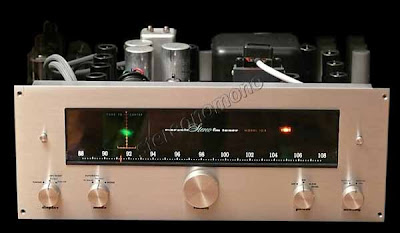
Without question the Model 10B is the most advanced instrument of its kind today. This is the Tuner that was rated by Hi/Fi Stereo Review (December, 1965 issue) as " ... we have neverseen a tuner to compare with it ... so outstanding that it is literally in a class by itself." Marantz engineers have bypassed the inherent limitations of conventional circuits through the employment of bold new concepts and highly sophisticated electronic techniques. The performance of every circuit stage shows the dramatic order of improvement which can be achieved through creative inventiveness.
Now, with the introduction of the Marantz 10B, all the requirements for real high fidelity reception have been met. FM reception with the Model 10B, is comparable in every degree with the clarity and fidelity normally found only in stereo tapes and discs.
Performance properties of the 10B in regard to quieting, stereo separation and distortion are without precedent. Its combination of high sensitivity, ultra-sharp selectivity, fast quieting action and reduced susceptibility to multipath effects, ensures exceptional results in fringe area. While the advanced features and performance specifications appeal to the primarily technically inclined, the Model10B's simplicity of operation attracts the listener who is simply a lover of good music. In whatever case, the extent of the new high standard established by this fine instrument is recognized by all of critical judgement.

RF Section
The precision tuning capacitor has a "Linear frequency" characteristic so that station calibrations appear evenly and accurately spaced along a full 10" tuning dial. RF stages are balanced-tuned throughout. An important feature is the radar-type, balanced-bridge diode mixer.
IF Section
The unique Marantz IF circuit is based on the development of an "18-pole" phase-linear. The ideal characteristic of the filter passband permit performance improvements which are unobtainable with conventional coupled circuits. Phase-linearity in the 200 kc passband eliminates a major source of high-frequency distortion and loss of separation 108 dB/octave cutoff slopes make the Model 10B the most selective FM tuner in existence. The strongest signals have no deteriorating effect on its ideal passband characteristics. IF alignment is permanent, being unaffected by tube changes or normal aging.
Limiters and Discriminator
There are 9 limiters in the Model 10B using matched pairs of silicon planar diodes. Each IF stage is self-limiting, preventing overload on stronge signals, and eliminating the usual need for AGC circuits. Quieting on weak signals is close to the theoretical threshold, with ultimate quieting well in excess of 70 dB. The discriminator circuit is extremely linear, ensuring low distortion through the subchannel range.

Multiplex
The highly sophisticated Marantz circuit permits the inclusion of phase correction to maintain proper phase-amplitude relationships. This allows the use of an extremely effective SCA rejection filter witout the usual loss of separation at high frequencies. Separation is well in excess of 30 dB to 15 kc. The output filter circuit provides very sharp attenuation of residual sub-channel components above the audio range, eliminating noise and interference from SCA. Precision-gapped ferrite cup-cores or precision toroidal coils are used for all filters. Automatic stereo switching and inter-channel muting are both accomplished by means of ingenious electronically triggered photo-electric circuits.
Multipath- Tuning Indicator
In March 1962, Marantz introduced the concept of using an oscilloscope tube as a multipath and tuning indicator in the early prototypes of the Model 10. As each station is tuned, its correct center position on the passband is clearly displayed. Simultaneously, the presence of multipath becomes visible, making it quite easy to readjust the antenna for best results. A panel switch permits test display of the left and right FM channels, or external signals from tape recorders, discs, etc.

SPECIFICATIONS
I.H.F. Sensitivity: 2 uv or better
Quieting Slope: 40 dB at 2 uv; 55 dB at 3,5 uv; 70 dB at 25 uv
6 IF Stages: Each with 3-pole phase-linear band-pass filter, IF bandwidth, 200 kc. Cutoff slopes 108 dB/octave
Selectivity Curve: Adjacent carrier - 42 dB; Alternate carrier - 150 dB
9 Dynamic Symmetrical-Aperture Limiters: Full limiting on noise
Ultra-Linear Discriminator: For low distortion through sub-channel range
Balanced-Bridge Diode Mixer
Automatic Stere Switching: Photoelectronic, with indicator light and threshold adjustment.
Interstation Muting: Photoelectronic, with defeat switch and threshold adjustment
Total Spurious Rejection: Better than 100 dB, Includes images, cross modulation, etc
Volume Sensitivity: 10 dB maximum (reached at 0,8 uv)
Harmonic Distortion: less than 0,2% at 15 kc after deemphasis, and less than 1% at detector
AM Rejection: At least 70 dB at 89% modulation with all signal levels
Separation: Approx. 45 dB average throughout the range. Better than 30 dB at 15 kc
Built-In Multipath/Tuning Indicator: 3" oscilloscope tube
Tuning Gang: Military type, silver plated, four balanced cections, ceramics spacers. Precision calibrated at 10 points.
Balanced 300 ohm Input
Dimensions:
Front panel 15⅜ x 5¾ inches; Chassis 14⅜ wide x 15 deep inches.
Panel Finish: Gold anodizedto match Model7
Shipping Weight: 38lbs

Nessun commento:
Posta un commento